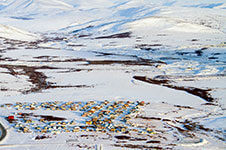Americans across the country rely on a secure internet connection to work and provide for their families, further their education, keep up with current news, and shop for products online. And for some people, having access to reliable broadband can quite literally be a matter of life and death.
One of the greatest advantages that comes with a more digital world is the ability to access health services online. Many people start their search for a provider online where they can search through reviews and easily find contact information and directions. Since the pandemic, many people are now utilizing telemedicine services for when they cannot physically make it into a provider’s office. In addition, people are also seeing the benefits it allows them in terms of versatility and convenience, as they are now able to meet with a medical provider from almost any location.
However, for people living on tribal lands or in rural parts of Alaska, a reliable internet connection might not be available. Unfortunately, it is these same areas that often struggle to access in-person medical services in the first place.
A major component in Quintillion’s overarching mission is to help bridge the digital divide and ensure that every Alaskan has the ability to access the internet from their home when they need it. When this goal is reached, it will enable people across the state to benefit from telemedicine and other vital digital services.
The Difficulty in Accessing Healthcare in Rural Alaska
In rural communities across the United States, access to healthcare and mental health services is an ever-growing issue. According to a study by the CDC, people who live in rural areas often struggle more with health issues than those who do not. Inhabitants of rural areas are also more likely to die from the five leading causes of death when compared to Americans in other parts of the U.S.
These issues are heightened by a lack of healthcare access, which can be due to a number of factors:
- Long travel distance to medical facilities
- Lack of specialists in the area
- Few choices in providers
- Higher likelihood of being uninsured
- Difficulties affording healthcare
- Poor social support or a stigma
Native Alaskans, along with other indigenous people across the country, often have poorer health than any other population in the United States. This is especially true of those living in rural areas. One analysis revealed that while only 12.1% of adults in the U.S. have a health rating of fair or poor, approximately 20% of American Indians or Alaska Natives reported this rating.
And the healthcare situation in Alaska is very unique. At 633,300 square miles, it is the largest state in the United States and is more than double the size of Texas. However, it has the lowest population density.
This means that there are many people spread out across a large area. It also means that many groups of people live in remote locations that aren’t easily accessible. It’s also incredibly difficult to get the proper personnel in place. Areas like the North Slopes offer limited sunshine, limited broadband, and Arctic-like conditions. Thus, little appeal for physicians to make the move.
In areas like the North Slopes where there is limited sunshine, Arctic conditions, and limited broadband, there is also little appeal for physicians to move to this area and offer services.
How Telemedicine Can Help Improve Access to Healthcare
Since the start of the pandemic, telemedicine is being utilized by people across the United States to access necessary health services without leaving their homes. While there are some services that people will always need to meet with a doctor in person for, telehealth appointments are a suitable alternative for many medical needs:
- Preventative care and routine check-ups
- Follow-up visits
- Chronic illness management
- Flu or cold appointments
- Minor urgent care needs
- Therapy appointments
- Nutrition coaching
- Lab result analyses
For people who live in rural areas and have a long commute to the nearest medical provider, growth in telemedicine services opens up many new opportunities for individuals who need medical care, especially for chronic or on-going conditions.
One area where virtual care has made the most significant impact is in mental health. Many rural communities are very sensitive to mental health issues, with higher rates of drug use, alcoholism, and suicide. For the state of Alaska as a whole, the “deaths of despair” rate (deaths caused by drugs, alcohol, or suicide) has consistently been much higher than the national average and has risen at a consistent rate.
While there are many factors that play a part in the mental health crisis happening in Alaska and other parts of the country, having difficulties finding a provider nearby is one. However, teletherapy removes the barrier of location for people in rural communities. As long as a provider is licensed in the state of Alaska, people in any part of the state can access care.
Bridging the Digital Divide and Telemedicine
While telemedicine has the potential to bring healthcare and mental health services to thousands of Alaskans, there are still many communities in Alaska that struggle to access reliable broadband services.
The COVID-19 pandemic has only emphasized these existing issues, as nation-wide shutdowns made seeing a medical provider in person nearly impossible. As the rest of the country has moved further into a new digital area, rural communities that lack the necessary broadband infrastructure are left behind. This leaves people unable to access the digital services that could help their community, especially when it comes to addressing very serious health emergencies and mental health issues.
For this reason, it’s essential that everyone in Alaska, even people living in the most remote locations in the state, can access the internet when they need it. Everyone needs the ability to access emergency services, utilize telemedicine, work remotely, or attend school virtually.
Federal Government Aid
Following the pandemic, the federal government released the Infrastructure and Jobs Act, which includes $65 billion in funding to help communities, especially underserved, rural, and Native areas, to build more internet infrastructure and bring down the costs of service.
In a recent Senate Committee on Indian Affairs (SCIA), the Vice Chairman Lisa Murkowski of the committee predicted that Native Alaska communities would receive the bulk of the allocated Tribal Broadband funds.
Murkowski, who is also the senator of Alaska, commented, “We are at a pivotal moment with many opportunities to expand broadband into places that have been unserved or underserved. This includes rural Alaska and especially Native villages. Many of the challenges that face Indian Country are similar but perhaps more pronounced in Alaska. While Tribes, states, and ANCs prepare to access these new investments, Alaska faces unique obstacles to extending robust broadband infrastructure to every community.”
The Quintillion Network
Fortunately, in the last few years, there has been incredible progress in bridging the digital divide in Alaska. In 2017, Quintillion completed its 1700-mile fiber optic cable system, which includes 1200 miles of subsea fiber and 500 miles of terrestrial fiber.
This system was focused on bringing fiber infrastructure to some of the rural Alaska communities that needed it most, including the Northwest and North Slope Arctic regions. Specifically, the network serves the Alaska markets of Nome, Kotzebue, Point Hope, Wainwright, Prudhoe Bay/Deadhorse, and Utqiaġvik. With this network in place, local internet service providers can offer high-speed, reliable fiber internet to residents in these regions.
Quintillion’s subsea fiber optic cable system is the first major step toward building a more connected Alaska, and already thousands of people have been connected with this network. However, there is still more opportunity to not only increase broadband access in every corner of Alaska but to make these services more affordable for end users as well.
Quintillion is passionate about enabling Alaskans to access broadband from every corner of the state. Learn more about how we support this mission.















